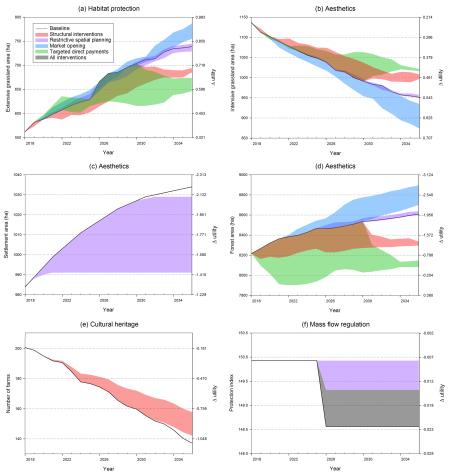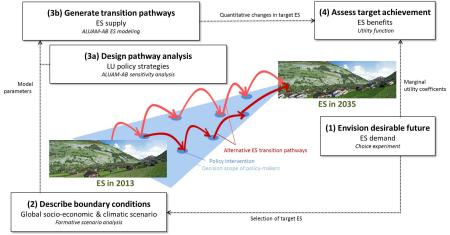
Resource description:
Advancing optimal management practices and designing relevant policy interventions for maintaining ecosystem services (ES) that satisfy local demand is a challenge in fragile mountain ecosystems. Under OPERAs, a backcasting framework (BackES) is being developed that develops and evaluates a variety of ES transition pathways and identifies types, combinations and timings of policy interventions that increase ES benefits. The underlying agent-based Alpine-Land-Use-Allocation-Model (ALUAM-AB) is tailored to simulate future changes in land use and ES triggered by the combined effects of climate, market and policy changes, while considering individual behaviour of local farmers.
Author/Contact:
Swiss Federal Institute of Technology Zurich
Planning of Landscape and Urban Systems (PLUS)
Sibyl Hanna Brunner: sbrunner@ethz.ch
Adrienne Gret-Regamey: gret@nsl.ethz.ch
Images
Requirements:
- BackES is an interdisciplinary,multi-method and time-intense approach.For example it draws upon an agreed vision of the future landscape in the form of quantitative levels of relevant ecosystem services.These should be elicited from relevant stakeholder g
- BackES uses ALUAM-AB which runs on Linear Programming Language and requires a CPLEX solver to solve the optimization problem.
- Applying ALUAM-AB to another case study region requires a lot of agro-economic expertise to adjust the model,many specific input data to parametrize the model and a lot of computational resources and time for generating multiple model runs for medium-term
Advantages:
- The backcasting approach explicitly considers future demand for and supply of ES and quantitatively assesses regional mismatches. It assesses not only the effectiveness of individual policy interventions in maintaining desired ES supply, but also the impo
- The model ALUAM-AB combines complex local decision-making and larger scale economic and political developments, which enables testing of multiple interventions across a range of scales and against different global change scenarios.
Constraints:
- BackES requires detailed spatial (e.g. elevation, precipitation, temperature, soil properties, crop yield, forest yield) and non-spatial data (socio-economic data and parameters related to agricultural practices, and political restrictions and programs (e
- A limiting factor is the high running time of the optimization model.
- Only a limited number of ES can be considered in evaluating ES mismatches due to methodological restrictions in quantitatively assessing future ES demand.
DOI reference:
http://www.sciencedirect.com/science/article/pii/S1364815215300761
http://www.sciencedirect.com/science/article/pii/S1462901116301241
Licence:
- Commercial
Development stage:
- Early access - beta phase

